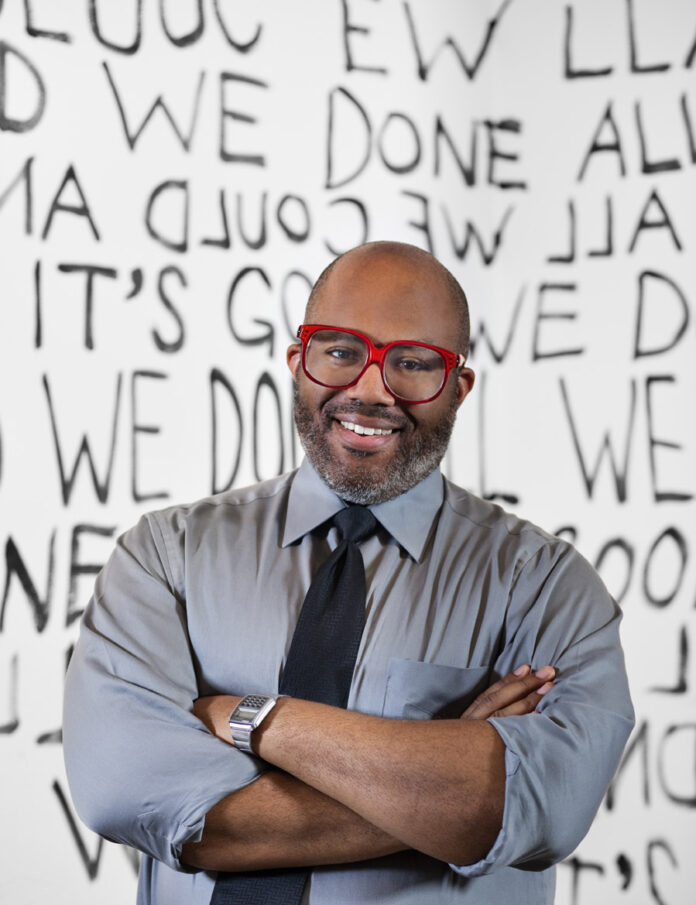On Sept. 5, the Martin Art Gallery virtually welcomed Trenton Doyle Hancock for an Artist’s Talk. An accredited artist with a Masters of Fine Arts from Temple University in Philadelphia, Hancock is also one of the youngest participants in the prestigious Whitney Biennial, the longest-running survey of American art. Zooming in from an office full of Super Mario Hats and Star Wars figurines, Hancock walked Muhlenberg community members through an in-depth breakdown of his process and pieces, afterwards engaging in a lively Q&A.
“One way to describe [my process],” Hancock stated, “is that it is a digestion or an investigation into my own identity.” Drawing on the influence of his “art grandfather” Philip Guston, Coco Fusco, James Baldwin, comic books and pop culture, Hancock’s pieces take viewers into a fantastical world known as the “Moundverse” in order to explore his very real experience as a Black man in America.
Due to the complexity of Moundverse mythology, it is imperative one have a baseline understanding of Hancock’s main characters to truly appreciate his work. The titular beings, Mounds, are half-human, half-flower piles of striped flesh that absorb negative energy. They also secrete positive energy and plasticized color, serve as memory repositories and are a means of connection. Hancock’s heroic alter-ego, TorpedoBoy, is the protector of these Mounds. Vegans, conversely, are goblin-like creatures that live in the Underworld, resenting Mounds and color.
The first piece Hancock discussed was an early iteration of “Devotion” (2013). A performance piece, “Devotion” saw Hancock become an immense, furry Mound. The director of the Contemporary Arts Museum Houston proceeded to feed him jello, prompting different vocalized and visual responses. In discussing this piece, Hancock shared, “One reason for doing performance is to test my boundaries, another to understand the characters… and there are always things left over!”
During his talk, Hancock also explored the ballet “Cult of Color: Call to Color” (2008), produced with Choreographer Stephen Mills and Composer Graham Reynolds for Ballet Austin. Following St. Sesom and a group of good Vegans, the ballet watches them discover color and combat the status quo.
Another powerful collection Hancock discussed was the series “Epidemic! Presents: Step and Screw!” (b. 1974), which follows TorpedoBoy as he interacts with Philip Guston’s character, a Klansman. Semi-biographical, the series also depicts lynching in his hometown of Paris, Texas. “There’s always a danger of putting that hood on,” said Hancock, referencing the Ku Klux Klan’s infamous white garment. To Hancock, that hood is a physical representation of white supremacy and inequitable power structures. Hence, the “Step and Screw” series evolved into TorpedoBoy trying to break away from the Klansman. In doing so, TorpedoBoy illustrates the importance of active resistance to such ideologies.
“Step and Screw” also epitomizes Hancock’s multidisciplinarity. Hancock expanded upon his style, stating, “I was trained as a cartoonist, but I… used that in the service of painting.” For example, Hancock incorporated text into “Step and Screw” by carving the characters’ dialogue into the canvas as “concrete poetry.” Furthermore, Hancock also utilizes unconventional objects. Born of a childhood hobby of collecting bottle caps, Hancock now incorporates pieces of found plastic as “little rewards one might get if they investigate the painting closer.” In reaction to Hancock’s style, Jonah King ‘28 shared, “His style jumps at you and makes you dizzy, and twists colors into bulging, kaleidoscopic, comic shapes! I was impressed… and reminded of the limitless power of a truly creative spirit.”
This extreme variety of mediums also prompted community members to ask “As you continue to create new works, how do you decide on the medium?” In response, Hancock commented, “Whatever I do, drawing it and writing it comes first.” When creating a new piece, he tries not to dictate what the idea will become as “the process tells you what the truth is.”
Also in the Q&A, Hancock approached the question “How did you get your artwork out there for everyone to see?” Hancock advised students to take a “boots on the ground” approach. “Be your own promoter,” he emphasized. “It’s all about being part of the ecosystem in that way… if you don’t show up, people won’t know you’re there.”
Jessica Ambler, Ph.D., the director of the Martin Art Gallery, gave insight into planning this event, sharing, “When looking to schedule an Artist’s Talk, the main question is ‘Who can we bring in to speak… who will have new insights to share with the community?’” Ambler believed Hancock was perfect for this because his work is “so inviting and the message is so incredibly deep.” She also wanted to express gratitude to Emily Potts, former visiting assistant professor of sculpture, and Thomas Petty, former exhibitions & collections manager of the Martin Art Gallery for their help in arranging this meeting.
Reflecting on the talk, Adrianna Fenu ‘28 commented “His art style is very exciting… I enjoyed getting to understand the reasoning behind his art. I feel as though you could smile and laugh at his work in the best possible way.”
To round out the conversation, Hancock promoted his upcoming exhibitions. In a full circle moment, the Jewish Museum will display his co-exhibition with Philip Guston starting Nov. 9. Meanwhile, his works can also be found at the James Cohan Art Gallery in New York City.






















